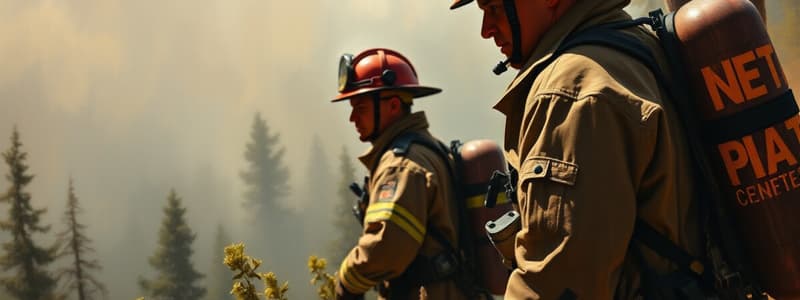Podcast
Questions and Answers
What is the primary purpose of maintaining LCES during wildland firefighting?
What is the primary purpose of maintaining LCES during wildland firefighting?
- To maximize firefighting efficiency
- To ensure crew accountability and safety (correct)
- To minimize the use of air support
- To coordinate with local authorities
What should happen immediately when aircraft is ordered during a wildland fire incident?
What should happen immediately when aircraft is ordered during a wildland fire incident?
- Continue drone operations as planned
- Increase the drone altitude for better visibility
- Land the drone immediately (correct)
- Notify all crew members to evacuate
Which of the following is NOT one of the Ten Standard Fire Orders?
Which of the following is NOT one of the Ten Standard Fire Orders?
- Utilize automated drones for scouting (correct)
- Maintain control of your forces at all times
- Fight fire aggressively, having provided for safety first
- Give clear instructions and ensure they are understood
Which situation does NOT increase the risk of injuries during wildland firefighting?
Which situation does NOT increase the risk of injuries during wildland firefighting?
What factor should influence all actions taken during wildland firefighting according to the basic orders?
What factor should influence all actions taken during wildland firefighting according to the basic orders?
What is a critical aspect to ensure during the use of lookouts?
What is a critical aspect to ensure during the use of lookouts?
Which of the following factors can significantly influence fire behavior?
Which of the following factors can significantly influence fire behavior?
When should fire line construction ideally not be performed?
When should fire line construction ideally not be performed?
Which of the following actions is essential to ensure crew accountability during wildland firefighting?
Which of the following actions is essential to ensure crew accountability during wildland firefighting?
What is the significance of identifying escape routes and safety zones before engaging in firefighting?
What is the significance of identifying escape routes and safety zones before engaging in firefighting?
Which situation significantly increases the likelihood of fire-related incidents for firefighting crews?
Which situation significantly increases the likelihood of fire-related incidents for firefighting crews?
What role does communication play during wildland firefighting operations?
What role does communication play during wildland firefighting operations?
What is a critical error that could occur during line construction related to safety?
What is a critical error that could occur during line construction related to safety?
How should weather conditions influence firefighting strategies?
How should weather conditions influence firefighting strategies?
Which aspect should be prioritized during aggressive firefighting efforts?
Which aspect should be prioritized during aggressive firefighting efforts?
What is a potential hazard when attempting a frontal assault on a fire?
What is a potential hazard when attempting a frontal assault on a fire?
What can result from failing to maintain control over crew members during a wildland fire operation?
What can result from failing to maintain control over crew members during a wildland fire operation?
Why is it critical to post lookouts in wildland firefighting?
Why is it critical to post lookouts in wildland firefighting?
Which of the following situations significantly increases the risk of injury during a wildland fire?
Which of the following situations significantly increases the risk of injury during a wildland fire?
What is the first step that should be taken when a drone is in operation during a wildland fire incident?
What is the first step that should be taken when a drone is in operation during a wildland fire incident?
Which action should be avoided to minimize injury risks while fighting wildland fires?
Which action should be avoided to minimize injury risks while fighting wildland fires?
What should be the basis for all actions taken during wildland firefighting?
What should be the basis for all actions taken during wildland firefighting?
In unfamiliar territory, what factor is crucial for optimizing safety among firefighting crews?
In unfamiliar territory, what factor is crucial for optimizing safety among firefighting crews?
What is a primary reason a firefighter should avoid constructing a fire line without clear instructions?
What is a primary reason a firefighter should avoid constructing a fire line without clear instructions?
Flashcards are hidden until you start studying
Study Notes
Crew Accountability and Safety
- Company Officers must maintain high awareness of crew accountability during wildland fires.
- Crew members may become spread out and hidden in rugged terrain, necessitating constant monitoring.
- Implement LCES: Lookouts, Communication, Escape Routes, Safety Zones for safe operations.
- The buddy system remains essential; crew members should watch out for one another.
- Drones must land immediately when any aircraft are ordered to ensure their safety and operational efficiency; no aircraft can operate while drones are in the air.
Ten Standard Fire Orders
- Personnel must stay informed on fire weather conditions and forecasts.
- Understanding the current behavior of the fire is crucial for safety.
- All actions taken should be based on present and expected fire behaviors.
- Escape routes and safety zones must be identified and communicated.
- Lookouts should be posted to warn of potential dangers.
- Maintaining calm, alertness, and decisiveness is essential in emergencies.
- Prompt and clear communication with all teams is vital for coordination.
- Clear instructions must be provided and confirmed for proper understanding.
- Control of all forces must be maintained to ensure safety.
- Aggressive firefighting should always prioritize safety first.
Eighteen Watch Out Situations
- Fire may be unsafe to engage if not scouted or assessed properly.
- Lack of visibility in unfamiliar terrain increases risk during nighttime operations.
- Safety zones and escape routes must be clearly identified before engagement.
- Local weather conditions and factors influencing fire behavior must be understood.
- Crew members should be informed about strategies, tactics, and hazards involved.
- Clear and concise instructions are necessary to avoid confusion.
- Maintaining a communication link with crew and supervisors is crucial.
- Constructing fire lines requires safe anchor points to prevent accidents.
- Avoid building fire lines downhill; dangers arise when fire is below.
- Frontal attacks on fires can be perilous without proper assessment.
- Unburned fuel between the firefighter and the fire increases risk.
- Always maintain visibility of the main fire and contact with someone who does.
- Avoid positions on hillsides where rolling materials can ignite fuels below.
- Monitor worsening weather conditions that can increase fire dangers.
- Watch for increasing wind speeds or shifts in direction.
- Frequent spot fires across the line indicate escalating risks.
- Difficult terrain and fuels can hinder escape to safety zones.
- Resting near the fire line can lead to dangerous situations.
Crew Accountability and Safety
- Company Officers must maintain high awareness of crew accountability during wildland fires.
- Crew members may become spread out and hidden in rugged terrain, necessitating constant monitoring.
- Implement LCES: Lookouts, Communication, Escape Routes, Safety Zones for safe operations.
- The buddy system remains essential; crew members should watch out for one another.
- Drones must land immediately when any aircraft are ordered to ensure their safety and operational efficiency; no aircraft can operate while drones are in the air.
Ten Standard Fire Orders
- Personnel must stay informed on fire weather conditions and forecasts.
- Understanding the current behavior of the fire is crucial for safety.
- All actions taken should be based on present and expected fire behaviors.
- Escape routes and safety zones must be identified and communicated.
- Lookouts should be posted to warn of potential dangers.
- Maintaining calm, alertness, and decisiveness is essential in emergencies.
- Prompt and clear communication with all teams is vital for coordination.
- Clear instructions must be provided and confirmed for proper understanding.
- Control of all forces must be maintained to ensure safety.
- Aggressive firefighting should always prioritize safety first.
Eighteen Watch Out Situations
- Fire may be unsafe to engage if not scouted or assessed properly.
- Lack of visibility in unfamiliar terrain increases risk during nighttime operations.
- Safety zones and escape routes must be clearly identified before engagement.
- Local weather conditions and factors influencing fire behavior must be understood.
- Crew members should be informed about strategies, tactics, and hazards involved.
- Clear and concise instructions are necessary to avoid confusion.
- Maintaining a communication link with crew and supervisors is crucial.
- Constructing fire lines requires safe anchor points to prevent accidents.
- Avoid building fire lines downhill; dangers arise when fire is below.
- Frontal attacks on fires can be perilous without proper assessment.
- Unburned fuel between the firefighter and the fire increases risk.
- Always maintain visibility of the main fire and contact with someone who does.
- Avoid positions on hillsides where rolling materials can ignite fuels below.
- Monitor worsening weather conditions that can increase fire dangers.
- Watch for increasing wind speeds or shifts in direction.
- Frequent spot fires across the line indicate escalating risks.
- Difficult terrain and fuels can hinder escape to safety zones.
- Resting near the fire line can lead to dangerous situations.
Crew Accountability and Safety
- Company Officers must maintain high awareness of crew accountability during wildland fires.
- Crew members may become spread out and hidden in rugged terrain, necessitating constant monitoring.
- Implement LCES: Lookouts, Communication, Escape Routes, Safety Zones for safe operations.
- The buddy system remains essential; crew members should watch out for one another.
- Drones must land immediately when any aircraft are ordered to ensure their safety and operational efficiency; no aircraft can operate while drones are in the air.
Ten Standard Fire Orders
- Personnel must stay informed on fire weather conditions and forecasts.
- Understanding the current behavior of the fire is crucial for safety.
- All actions taken should be based on present and expected fire behaviors.
- Escape routes and safety zones must be identified and communicated.
- Lookouts should be posted to warn of potential dangers.
- Maintaining calm, alertness, and decisiveness is essential in emergencies.
- Prompt and clear communication with all teams is vital for coordination.
- Clear instructions must be provided and confirmed for proper understanding.
- Control of all forces must be maintained to ensure safety.
- Aggressive firefighting should always prioritize safety first.
Eighteen Watch Out Situations
- Fire may be unsafe to engage if not scouted or assessed properly.
- Lack of visibility in unfamiliar terrain increases risk during nighttime operations.
- Safety zones and escape routes must be clearly identified before engagement.
- Local weather conditions and factors influencing fire behavior must be understood.
- Crew members should be informed about strategies, tactics, and hazards involved.
- Clear and concise instructions are necessary to avoid confusion.
- Maintaining a communication link with crew and supervisors is crucial.
- Constructing fire lines requires safe anchor points to prevent accidents.
- Avoid building fire lines downhill; dangers arise when fire is below.
- Frontal attacks on fires can be perilous without proper assessment.
- Unburned fuel between the firefighter and the fire increases risk.
- Always maintain visibility of the main fire and contact with someone who does.
- Avoid positions on hillsides where rolling materials can ignite fuels below.
- Monitor worsening weather conditions that can increase fire dangers.
- Watch for increasing wind speeds or shifts in direction.
- Frequent spot fires across the line indicate escalating risks.
- Difficult terrain and fuels can hinder escape to safety zones.
- Resting near the fire line can lead to dangerous situations.
Studying That Suits You
Use AI to generate personalized quizzes and flashcards to suit your learning preferences.




